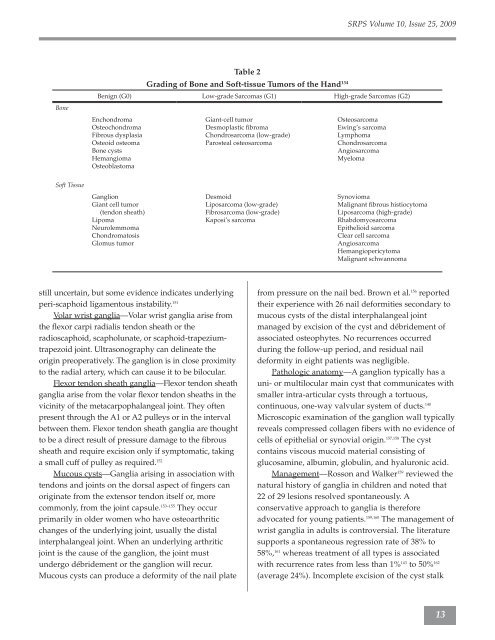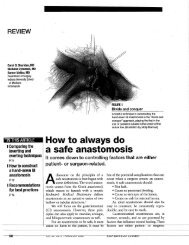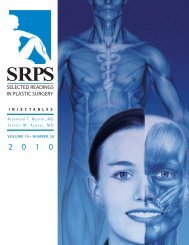SRPS PS - Plastic Surgery Internal
SRPS PS - Plastic Surgery Internal
SRPS PS - Plastic Surgery Internal
You also want an ePaper? Increase the reach of your titles
YUMPU automatically turns print PDFs into web optimized ePapers that Google loves.
Bone<br />
Soft Tissue<br />
still uncertain, but some evidence indicates underlying<br />
peri-scaphoid ligamentous instability. 151<br />
Volar wrist ganglia—Volar wrist ganglia arise from<br />
the flexor carpi radialis tendon sheath or the<br />
radioscaphoid, scapholunate, or scaphoid-trapeziumtrapezoid<br />
joint. Ultrasonography can delineate the<br />
origin preoperatively. The ganglion is in close proximity<br />
to the radial artery, which can cause it to be bilocular.<br />
Flexor tendon sheath ganglia—Flexor tendon sheath<br />
ganglia arise from the volar flexor tendon sheaths in the<br />
vicinity of the metacarpophalangeal joint. They often<br />
present through the A1 or A2 pulleys or in the interval<br />
between them. Flexor tendon sheath ganglia are thought<br />
to be a direct result of pressure damage to the fibrous<br />
sheath and require excision only if symptomatic, taking<br />
a small cuff of pulley as required. 152<br />
Mucous cysts—Ganglia arising in association with<br />
tendons and joints on the dorsal aspect of fingers can<br />
originate from the extensor tendon itself or, more<br />
commonly, from the joint capsule. 153–155 They occur<br />
primarily in older women who have osteoarthritic<br />
changes of the underlying joint, usually the distal<br />
interphalangeal joint. When an underlying arthritic<br />
joint is the cause of the ganglion, the joint must<br />
undergo débridement or the ganglion will recur.<br />
Mucous cysts can produce a deformity of the nail plate<br />
Table 2<br />
Grading of Bone and Soft-tissue Tumors of the Hand134 <strong>SR<strong>PS</strong></strong> Volume 10, Issue 25, 2009<br />
Benign (G0) Low-grade Sarcomas (G1) High-grade Sarcomas (G2)<br />
Enchondroma<br />
Osteochondroma<br />
Fibrous dysplasia<br />
Osteoid osteoma<br />
Bone cysts<br />
Hemangioma<br />
Osteoblastoma<br />
Ganglion<br />
Giant cell tumor<br />
(tendon sheath)<br />
Lipoma<br />
Neurolemmoma<br />
Chondromatosis<br />
Glomus tumor<br />
Giant-cell tumor<br />
Desmoplastic fi broma<br />
Chondrosarcoma (low-grade)<br />
Parosteal osteosarcoma<br />
Desmoid<br />
Liposarcoma (low-grade)<br />
Fibrosarcoma (low-grade)<br />
Kaposi’s sarcoma<br />
Osteosarcoma<br />
Ewing’s sarcoma<br />
Lymphoma<br />
Chondrosarcoma<br />
Angiosarcoma<br />
Myeloma<br />
Synovioma<br />
Malignant fi brous histiocytoma<br />
Liposarcoma (high-grade)<br />
Rhabdomyosarcoma<br />
Epithelioid sarcoma<br />
Clear cell sarcoma<br />
Angiosarcoma<br />
Hemangiopericytoma<br />
Malignant schwannoma<br />
from pressure on the nail bed. Brown et al. 156 reported<br />
their experience with 26 nail deformities secondary to<br />
mucous cysts of the distal interphalangeal joint<br />
managed by excision of the cyst and débridement of<br />
associated osteophytes. No recurrences occurred<br />
during the follow-up period, and residual nail<br />
deformity in eight patients was negligible.<br />
Pathologic anatomy—A ganglion typically has a<br />
uni- or multilocular main cyst that communicates with<br />
smaller intra-articular cysts through a tortuous,<br />
continuous, one-way valvular system of ducts. 140<br />
Microscopic examination of the ganglion wall typically<br />
reveals compressed collagen fibers with no evidence of<br />
cells of epithelial or synovial origin. 157,158 The cyst<br />
contains viscous mucoid material consisting of<br />
glucosamine, albumin, globulin, and hyaluronic acid.<br />
Management—Rosson and Walker 159 reviewed the<br />
natural history of ganglia in children and noted that<br />
22 of 29 lesions resolved spontaneously. A<br />
conservative approach to ganglia is therefore<br />
advocated for young patients. 159,160 The management of<br />
wrist ganglia in adults is controversial. The literature<br />
supports a spontaneous regression rate of 38% to<br />
58%, 161 whereas treatment of all types is associated<br />
with recurrence rates from less than 1% 143 to 50% 162<br />
(average 24%). Incomplete excision of the cyst stalk<br />
13






